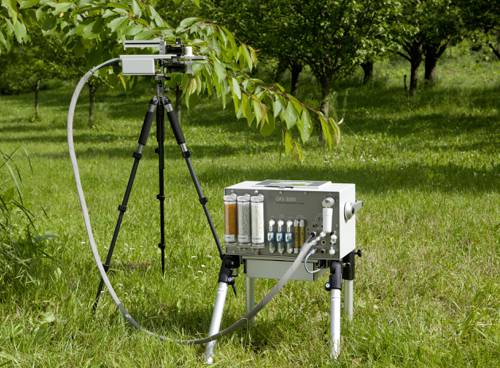
FAQ About Indoor Plant Breathing and Gas Exchange

How do indoor plants breathe?
Indoor plants breathe through a process called gas exchange, which primarily occurs through openings in their leaves known as stomata. During the day, plants absorb carbon dioxide (CO2) and release oxygen (O2) through these stomata as part of photosynthesis. At night, the process reverses slightly, as they consume oxygen and release carbon dioxide through respiration.

What role do stomata play in plant breathing?
Stomata are small openings on the surfaces of leaves that allow gases to enter and exit the plant. They are crucial for photosynthesis, as they permit carbon dioxide to enter and oxygen to leave. Stomata also facilitate transpiration, the process of water vapor leaving the plant, which helps to cool the plant and drive nutrient uptake from the roots.

Can indoor plants improve air quality?
Yes, indoor plants can improve air quality by absorbing pollutants like formaldehyde, benzene, and trichloroethylene, through their leaves and roots. They also increase humidity through the process of transpiration, which can help to alleviate respiratory issues and make indoor environments more comfortable.

Do indoor plants require carbon dioxide at night?
While plants primarily take up carbon dioxide during the day for photosynthesis, they also respire at night. During respiration, they consume oxygen and release small amounts of carbon dioxide. However, the levels of CO2 required at night are much lower than during the day.

How does light affect the gas exchange process in indoor plants?
Light affects the gas exchange process by driving photosynthesis, which requires light to turn carbon dioxide and water into glucose and oxygen. In brighter light, the stomata typically open wider to intake more CO2, enhancing the plant's ability to photosynthesize and grow.

Why is photosynthesis important for indoor plants?
Photosynthesis is crucial for indoor plants because it allows them to create their own food using sunlight, water, and carbon dioxide. This process not only supports plant growth and energy but also produces oxygen as a byproduct, contributing to air purification in indoor environments.

Do indoor plants respire more at night?
Indoor plants respire 24/7, but their respiration is more noticeable at night when photosynthesis is not occurring. During nighttime respiration, plants generally consume oxygen and release carbon dioxide, contrasting with daytime when photosynthesis offsets carbon dioxide release.

How do indoor plants affect oxygen levels?
During the day, indoor plants contribute to oxygen levels by releasing O2 through photosynthesis. Though they do absorb some oxygen at night for respiration, the overall effect is positive, increasing oxygen availability within indoor environments.

What is the impact of too much carbon dioxide on indoor plants?
While carbon dioxide is essential for photosynthesis, excessively high levels can be harmful to plants. It can lead to imbalances in photosynthesis rates and potentially result in physiological stress. Ensuring adequate ventilation helps maintain balanced CO2 levels beneficial for plant growth.

Why do indoor plants release carbon dioxide at night?
At night, photosynthesis ceases due to the absence of light, and plants rely solely on respiration. During respiration, indoor plants break down sugars created during the day, which involves consuming oxygen and releasing carbon dioxide as a byproduct.

How can indoor plant placement affect gas exchange?
Placement can greatly affect gas exchange by influencing light exposure and air circulation. Placing plants near natural light sources like windows optimizes photosynthesis, while good air flow facilitates stomatal efficiency and healthy respiration.

What are CAM plants and how do they handle gas exchange differently?
CAM (Crassulacean Acid Metabolism) plants, such as succulents, open their stomata at night to minimize water loss while still allowing for gas exchange. This adaptation is particularly useful in arid environments and helps them survive with minimal moisture.

Do all indoor plants perform gas exchange the same way?
Not all indoor plants perform gas exchange in the same way. For example, CAM plants, like cacti and succulents, adjust their stomatal cycle to open at night, differing from most plants that open them during the day. This adaptation helps in conserving water.

How does humidity affect gas exchange in indoor plants?
Humidity can influence gas exchange by affecting the rate of water vapor loss through stomata. Higher humidity reduces transpiration rates, potentially limiting the plant’s ability to uptake CO2 during photosynthesis, while low humidity can lead to excessive water loss.

What are common indoor plant species that improve air quality?
Some common indoor plants known for improving air quality include the peace lily, snake plant, spider plant, and pothos. These plants are effective at filtering out pollutants like formaldehyde and benzene, thus enhancing the air quality in indoor spaces.

Why are some indoor plants called "air purifiers"?
Certain indoor plants are referred to as "air purifiers" because they have the ability to remove volatile organic compounds (VOCs) and other toxins from the air. They accomplish this through processes like gas exchange and the microbial activity in their root systems.

How does soil quality affect plant respiration and gas exchange?
Soil quality affects respiration and gas exchange by influencing root health and microbial activity. Aerated, nutrient-rich soil supports root respiration and optimal water and nutrient uptake, which in turn supports efficient leaf gas exchange.

What benefits do plants provide to indoor environments beyond gas exchange?
Besides gas exchange, plants enhance indoor environments by increasing humidity, reducing stress, improving mood, and even boosting productivity. Their presence also adds aesthetic value and a natural element to the indoor decor.

How does temperature influence indoor plant gas exchange processes?
Temperature influences gas exchange by affecting enzyme activity crucial for photosynthesis and respiration. Generally, warmer temperatures increase the rate of these processes up to a point, beyond which heat stress can negatively affect plant metabolism and growth.

What signs indicate that a plant's gas exchange may be inhibited?
Signs of inhibited gas exchange include wilting, chlorosis (yellowing of leaves), and stunted growth. These symptoms may suggest issues like poor air circulation, overwatering, or inadequate light, which can impair stomatal function and overall plant health.
